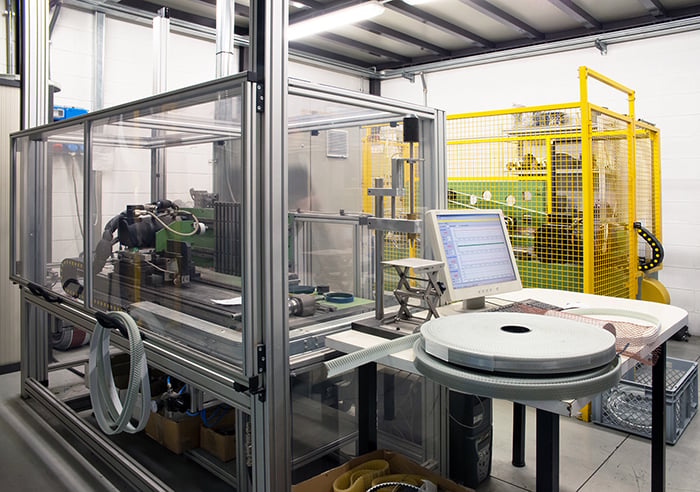Many manufacturers require the importation of mechanical, electrical, and electronic manufacturing equipment into the UK.
Capital equipment is used to manufacture products or provide services, and covers a broad spectrum of items. How can manufacturers ensure safe importation without encountering potentially costly delays caused by the red tape of regulations such as UKCA marking?
In this article, we’ll focus on UKCA marking and its implications for capital equipment being imported into the UK.

Standards applied to capital equipment imported to the UK
Importers into the UK need to be aware of the marking regulations which high-technology manufacturing equipment falls under.
Before capital equipment can be imported to the UK, it must comply with UKCA marking standards that came into effect on 31st December, 2020.
At the end of 2024, UKCA marking will completely replace CE marking as the mark of compliance for goods imported into the UK (CE marking will be accepted up until the end of 2024, and thereafter will only apply to goods imported to the European Union).
Displaying the UKCA mark demonstrates that capital equipment meets all requirements of its applicable legislation, before it can be sold on, or supplied to, the UK market.
Which capital equipment needs UKCA marking?
Every piece of capital equipment imported into the UK will require UKCA marking. The regulations which apply to equipment - and which must be complied with in order to display the UKCA mark - will depend on its type.

Mechanical, electrical and electronic equipment must meet the requirements of regulations such as:
UK Supply of Machinery (Safety) Regulations
The UK Supply of Machinery (Safety) Regulations are a series of health and safety requirements that apply to many types of capital equipment. The regulations concern any machinery used in the workplace, and are applied to the sale and supply of such capital equipment in the UK.
All capital equipment in the scope of the UK Supply of Machinery (Safety) Regulations must be UKCA marked. The regulations provide a legislative framework and place responsibilities on manufacturers and OEMs to prevent harm or damage being caused by capital equipment.
A broad range of manufacturing equipment and production tools must be tested for conformity with the regulations, including:
- Various types of assemblies
- Controls
- Safety components
- Drive systems
Read our guide on the UK Supply of Machinery (Safety) Regulations
UK Electrical Equipment (Safety) Regulations
The UK Electrical Equipment (Safety) Regulations apply to capital equipment designed for use within specific voltage limits.
Health and safety measures in the regulations seek to protect operators against electric shock, fire hazards and mechanical risks. In this way, the regulations ensure that electrical capital equipment is safe and doesn’t pose a risk to users or their environment.
All capital equipment that falls under the UK Electrical Equipment (Safety) Regulations must be UKCA marked. Conformity testing will form the basis of achieving UKCA marking compliance.
The regulations apply to the majority of capital equipment within the following voltage brackets:
- 50 - 1000 V for alternating current
- 75 - 1500 V for direct current
Read our guide on the UK Electrical Equipment (Safety) Regulations
UK Electromagnetic Compatibility (EMC) Regulations
The UK Electromagnetic Compatibility (EMC) Regulations cover electrical and electronic equipment. This legislation ensures that capital equipment:
- Doesn't cause electromagnetic disturbance
- Isn't disturbed by electromagnetic interference
The regulations apply to many types of capital equipment which typically generate electromagnetic disturbance, and are being placed on the UK market or taken into service.
There are some exceptions, including equipment with conformity governed by other specific requirements or regulations.
Testing on capital equipment is fundamental to EMC Regulations conformity and UKCA marking compliance. These assessments include:
- radiated emissions
- conducted emissions
- radiated susceptibility
- conducted susceptibility
- electrostatic discharge
Read our guide on the UK Electromagnetic Compatibility (EMC) Regulations
Compliance testing for capital equipment
The basis of achieving UKCA marking conformity is often compliance testing, which ensures that equipment adheres to its relevant regulations.
In order to simplify the path to compliance for equipment previously tested for CE marking conformance, in January 2024 the government announced plans for a UKCA marking ‘fast-tracking’ system that will allow a mixture of UK and EU conformity assessments.
Declaration and documentation
UKCA mark
To comply with the regulations outlined above, the UKCA mark should be affixed directly on capital equipment, as well as its packaging and guaranteed certificates.
Displaying the UKCA mark demonstrates that equipment conforms with the regulations and can be sold or taken into service in the UK.
Technical documentation
A Technical File must be compiled by manufacturers, demonstrating compliance with applicable regulations.
The Technical File will include:
- Description of the capital equipment
- Design and drawings of the capital equipment, including how it was manufactured and details of how it is operated
- Proof of compliance with harmonised standards (including details of conformity assessments)
Declaration of Conformity
The route to UKCA marking compliance is concluded by a Declaration of Conformity (DoC) being made. This is a written declaration by the manufacturer or an appointed authorised representative.
A DoC states that the capital equipment complies with relevant regulations, and contains details including the identification of the manufacturer or representative, the equipment itself, and the standards applied.
Discover how we fast-tracked UKCA marking compliance for a pioneering manufacturer and importer of sustainable security solutions, allowing the company to capitalise on a market opportunity.
Do you have a question on UKCA marking for capital equipment? Contact us today using our contact form.




